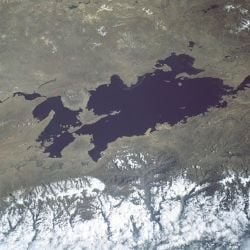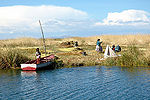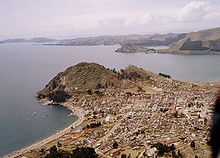Difference between revisions of "Lake Titicaca" - New World Encyclopedia
Mary Anglin (talk | contribs) (import credit and claim for Anglin) |
Vicki Phelps (talk | contribs) |
||
| Line 7: | Line 7: | ||
|caption_bathymetry = | |caption_bathymetry = | ||
|coords = {{coor at dm|16|0|S|69|0|W|type:waterbody}} | |coords = {{coor at dm|16|0|S|69|0|W|type:waterbody}} | ||
| − | |type = | + | |type = Mountain Lake |
|inflow = 27 rivers | |inflow = 27 rivers | ||
| − | |outflow = | + | |outflow = Desaguadero River<br/>Evaporation |
|catchment = 58,000 km² | |catchment = 58,000 km² | ||
| − | |basin_countries = | + | |basin_countries = Peru<br/>Bolivia |
|length = 190 km | |length = 190 km | ||
|width = 80 km | |width = 80 km | ||
| Line 20: | Line 20: | ||
|shore = 1,125 km | |shore = 1,125 km | ||
|elevation = 3,812 m | |elevation = 3,812 m | ||
| − | |islands = 42+ islands<br>See Article | + | |islands = 42+ islands<br/>See Article |
| − | |cities = | + | |cities = Puno, Peru<br/>Copacabana, Bolivia |
}} | }} | ||
| − | '''Lake Titicaca''' is the highest commercially navigable lake in the world,<ref>[http://www.highestlake.com/highest-lake-world.html The Highest Lake in the World] Carl Drews, | + | '''Lake Titicaca''' is the highest commercially navigable lake in the world,<ref>[http://www.highestlake.com/highest-lake-world.html The Highest Lake in the World] Carl Drews, 13 September 2005. Retrieved 2 December 2006.</ref> at 3,812 [[metre|m]] (12,507 feet) above sea level. Located in the [[Altiplano]] high in the [[Andes]] on the border of [[Peru]] and [[Bolivia]], at 16°S 69°W, Titicaca has an average depth of 107 m,<ref>[http://www.ilec.or.jp/database/sam/dsam04.html Data Summary: Lago Titicaca (Lake Titicaca)] www.ilec.or.jp, International Lake Environment Committee Foundation - ILEC. Retrieved 2 December 2006. </ref> and a maximum depth of 281 m. The western part of the lake belongs to the Puno Region of Peru, and the eastern side is located in the Bolivian La Paz Department. |
More than 25 [[river]]s empty into Titicaca, and the lake has 41 islands, some of which are densely populated. | More than 25 [[river]]s empty into Titicaca, and the lake has 41 islands, some of which are densely populated. | ||
| Line 52: | Line 52: | ||
== Name == | == Name == | ||
[[Image:Copacabana.jpg|thumb|left|220px|Copacabana, Bolivia]] | [[Image:Copacabana.jpg|thumb|left|220px|Copacabana, Bolivia]] | ||
| − | The origin of the name Titicaca is unknown. It has been translated as "Rock Puma" | + | The origin of the name Titicaca is unknown. It has been translated as "Rock Puma," allegedly because of its resemblance to the shape of a puma hunting a rabbit, combining words from the local languages [[Quechua language|Quechua]] and [[Aymara language|Aymara]], and as well as translated as "Crag of Lead." Locally, the lake goes by several names. Because the southeast quarter of the lake is separate from the main body (connected only by the [[Strait of Tiquina]]), the Bolivians call it ''Lago Huiñaymarca'' ({{lang-qu|Wiñay Marka}}) and the larger part ''Lago Chucuito.'' In Peru, these smaller and larger parts are referred to as ''Lago Pequeño'' and ''Lago Grande'', respectively. |
== Other notable facts== | == Other notable facts== | ||
Revision as of 02:57, 13 December 2007
| Lake Titicaca | |
|---|---|
| Coordinates | |
| Lake type | Mountain Lake |
| Primary sources | 27 rivers |
| Primary outflows | Desaguadero River Evaporation |
| Catchment area | 58,000 km² |
| Basin countries | Peru Bolivia |
| Max length | 190 km |
| Max width | 80 km |
| Surface area | 8,372 km² |
| Average depth | 107m |
| Max depth | 281m |
| Water volume | 893 km³ |
| Shore length1 | 1,125 km |
| Surface elevation | 3,812 m |
| Islands | 42+ islands See Article |
| Settlements | Puno, Peru Copacabana, Bolivia |
| 1 Shore length is an imprecise measure which may not be standardized for this article. | |
Lake Titicaca is the highest commercially navigable lake in the world,[1] at 3,812 m (12,507 feet) above sea level. Located in the Altiplano high in the Andes on the border of Peru and Bolivia, at 16°S 69°W, Titicaca has an average depth of 107 m,[2] and a maximum depth of 281 m. The western part of the lake belongs to the Puno Region of Peru, and the eastern side is located in the Bolivian La Paz Department.
More than 25 rivers empty into Titicaca, and the lake has 41 islands, some of which are densely populated.
Titicaca is fed by rainfall and meltwater from glaciers on the sierras that abut the Altiplano. It is drained by the Desaguadero River, which flows south through Bolivia to Lake Poopó. This accounts for less than five percent of the lake's water loss, however, the rest is caused by evaporation as a result of the strong winds and sunlight at this altitude.
Islands
Uros
Titicaca is notable for a population of people who live on the Uros, a group of about 43 artificial islands made of floating reeds. These islands have become a major tourist attraction for Peru, drawing excursions from the lakeside city of Puno. Their original purpose was defensive, and they could be moved if a threat arose. One of the islands retains a watchtower largely constructed of reeds.
Amantaní

Amantaní is another small island in Lake Titicaca populated by Quechua speakers. About 800 families live in six villages on the basically circular 15-square kilometer island. There are two mountain peaks, called Pachatata (Father Earth) and Pachamama (Mother Earth), and ancient ruins on the top of both peaks. The hillsides that rise up from the lake are terraced and planted with wheat, potatoes, and vegetables. Most of the small fields are worked by hand. Long stone fences divide the fields, and cattle, sheep, and alpacas graze on the hillsides.
There are no cars on the island, and no hotels. A few small stores sell basic goods, and there is a health clinic and school. Electricity is produced by a generator and limited to a couple of hours each day.
Some of the families on Amantaní open their homes to tourists for overnight stays and provide cooked meals, arranged through tour guides. The families who do so are required to have a special room set aside for the tourists and must fit a code by the tour companies that help them. Guests typically take food staples (cooking oil, rice, sugar) as a gift or school supplies for the children on the island. They hold nightly traditional dance shows for the tourists where they offer to dress them up in their traditional clothes and participate.
Isla del Sol
Situated on the Bolivian side of the lake with regular boat links to the Bolivian town of Copacabana, Isla del Sol ("Island of the Sun") is one of the lake's largest islands. In Inca mythology it figured as the place of their origin, and several important Inca ruins exist on the island. Its economy is mainly driven by tourism revenues, but subsistence agriculture and fishing are widely practised. An underwater archaeological research project was undertaken off the Island of the Sun during 1989-92. Rare Inca and Tiahuanaco artifacts were recovered, which are currently on display in a site museum in Challapampa.[3]
Name
The origin of the name Titicaca is unknown. It has been translated as "Rock Puma," allegedly because of its resemblance to the shape of a puma hunting a rabbit, combining words from the local languages Quechua and Aymara, and as well as translated as "Crag of Lead." Locally, the lake goes by several names. Because the southeast quarter of the lake is separate from the main body (connected only by the Strait of Tiquina), the Bolivians call it Lago Huiñaymarca (Template:Lang-qu) and the larger part Lago Chucuito. In Peru, these smaller and larger parts are referred to as Lago Pequeño and Lago Grande, respectively.
Other notable facts
The Bolivian Naval Force uses the lake to carry out naval exercises, maintaining an active navy despite being landlocked.
The partly-salt Lake Maracaibo in Venezuela is the only body of water in South America bigger than Titicaca, at about 13,000 square kilometres, but some say it should be classified as a sea because it is connected to the ocean.
Anthropologist Hermann Baumann documented male-to-female transsexual priestesses among original villagers living along Lake Titicaca.[4]
ReferencesISBN links support NWE through referral fees
- ↑ The Highest Lake in the World Carl Drews, 13 September 2005. Retrieved 2 December 2006.
- ↑ Data Summary: Lago Titicaca (Lake Titicaca) www.ilec.or.jp, International Lake Environment Committee Foundation - ILEC. Retrieved 2 December 2006.
- ↑ Reinhard, Johan "Underwater Archaeological Research in Lake Titicaca, Bolivia" in Ancient America: Contributions to New World Archaeology, 1992. N. Saunders (ed.), Oxford: Oxbow Books, pp. 117-143
- ↑ Feinberg, Leslie: Transgender Warriors, page 40. Beacon Press, 1996.
External links
- World lake database entry for Lake Titicaca
- Bolivian Navy and Naval Ensign
- Lake Titicaca - The Highest Navigable Lake in the World Information about the floating islands and Isla del Sol
- Ancient Temple found under the waters of Lake Titicaca
- Management issues in the Lake Titicaca and Lake Poopo system: Importance of developing a water budget
Credits
New World Encyclopedia writers and editors rewrote and completed the Wikipedia article in accordance with New World Encyclopedia standards. This article abides by terms of the Creative Commons CC-by-sa 3.0 License (CC-by-sa), which may be used and disseminated with proper attribution. Credit is due under the terms of this license that can reference both the New World Encyclopedia contributors and the selfless volunteer contributors of the Wikimedia Foundation. To cite this article click here for a list of acceptable citing formats.The history of earlier contributions by wikipedians is accessible to researchers here:
The history of this article since it was imported to New World Encyclopedia:
Note: Some restrictions may apply to use of individual images which are separately licensed.





